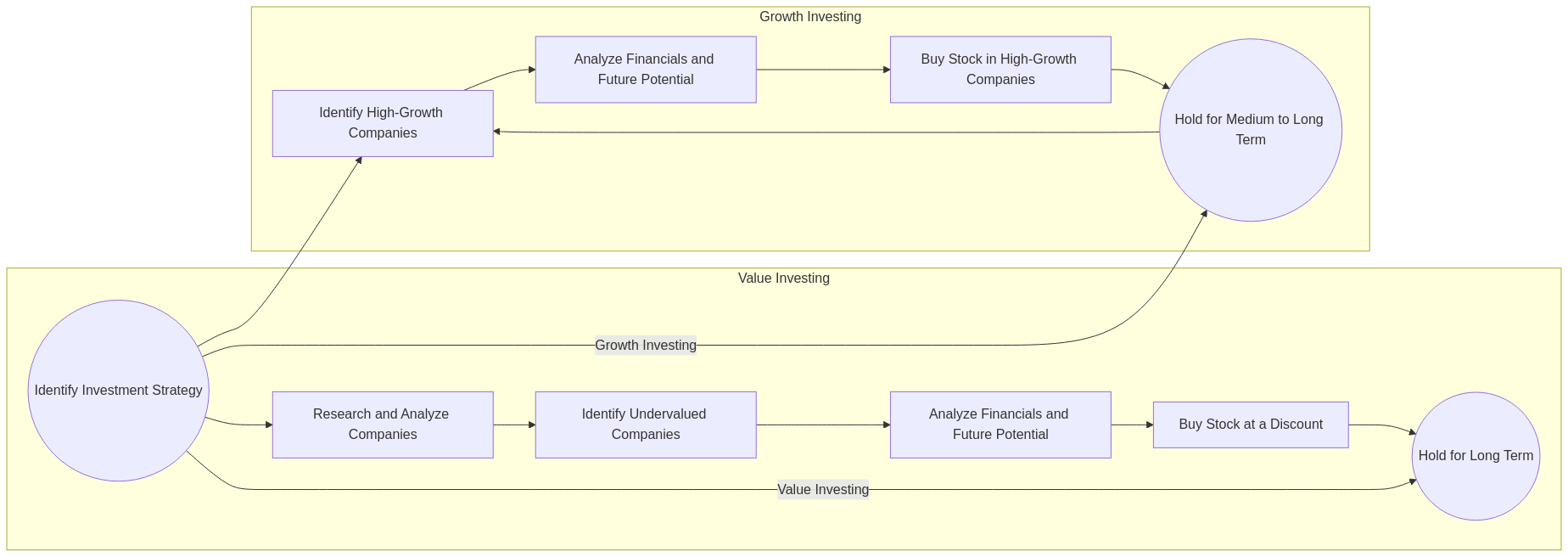Investing in the stock market can be a daunting task for beginners. With so many different investment strategies out there, it can be tough to determine which one is right for you. Two of the most popular investment strategies are value investing and growth investing. In this article, we will discuss the key differences between these two investment strategies and help you decide which one is right for you.
What is Value Investing?
Value investing is an investment strategy that focuses on investing in stocks that are currently undervalued by the market. The goal is to buy these stocks at a discount and then hold them until their true value is realized. Value investors believe that the market tends to overreact to short-term news and that over time, the market will recognize the true value of the stock.
The Principles of Value Investing
Value investing is based on several key principles. The major ones include:
- Investing in undervalued stocks: Value investors look for stocks that are currently undervalued by the market. They use fundamental analysis to determine the true value of a stock and compare it to its current market price.
- Investing in companies with strong fundamentals: Value investors look for companies that have a strong balance sheet, steady earnings growth, and a proven track record of success.
- Focusing on long-term growth: Value investors are typically focused on long-term growth and are willing to hold onto a stock for years until its true value is realized.
The Pros and Cons of Value Investing
Like everything, Value investing also has some pros and cons. Some of the pros include:
- Potential for high returns: Value investing has the potential for high returns if you are able to find undervalued stocks and hold onto them until their true value is realized.
- Lower risk: Value investing is typically considered to be less risky than other investment strategies because you are investing in stocks that are already undervalued.
- Long-term focus: Value investing is focused on long-term growth, which can be beneficial for investors who are looking for a steady, consistent return on their investment.
Some of the cons of value investing include:
- Limited short-term gains: Value investing is focused on long-term growth, which means that you may not see significant gains in the short-term.
- Time-consuming: Value investing requires a significant amount of research and analysis, which can be time-consuming for investors.
- Limited diversification: Because value investors are focused on a specific type of stock, they may not have as much diversification in their portfolio as other investors.
What is Growth Investing?
Growth investing is an investment strategy that focuses on investing in stocks that have the potential for high growth. The goal is to buy these stocks when they are still in their early stages of growth and then hold onto them as they continue to grow. Growth investors believe that these stocks will continue to outperform the market over time.
The Principles of Growth Investing
The key principles of Growth investing is to look for potential that is missed by the eyes of the public.
- Investing in companies with high growth potential: Growth investors look for companies that are in the early stages of growth and have the potential to grow significantly in the future.
- Investing in companies with a competitive advantage: Growth investors look for a preemptive advantage or unique selling proposition that sets the company apart from its competitors.
- Focusing on earnings growth: Growth investors focus on companies with strong earnings growth, even if those companies may not be profitable in the short-term.
The Pros and Cons of Growth Investing
There are both advantages and disadvantages to growth investing. Some of the benefits are listed below:
- Potential for high returns: Growth investing has the potential for high returns if you are able to invest in the right companies at the right time.
- Diversification: Growth investors typically invest in a range of different industries and sectors, which can help to diversify their portfolio.
- Exciting and dynamic: Growth investing can be exciting and dynamic because you are investing in companies that are in the early stages of growth.
There are also some drawbacks to consider such as:
- High risk: Growth investing is typically considered to be more risky than other investment strategies because you are investing in companies that are still in their early stages of growth.
- Volatility: Growth stocks can be more volatile than other types of stocks because their share prices are often based on future earnings potential rather than current earnings.
- Short-term focus: Growth investors are typically focused on short-term earnings growth, which can make it difficult to predict long-term returns.
Key Differences Between Value Investing and Growth Investing
When it comes to investing, there are two primary schools of thought: Value investing and Growth investing. While both strategies aim to generate profits over a long term, they differ in several criteria like Investment Philosophy, Risk Tolerance, Investment horizon
- Investing Philosophy
Value investing is based on the principle that the market tends to overreact to short-term news and that over time, the market will recognize the true value of a stock. Growth investing, on the other hand, is focused on investing in companies with high growth potential, even if those companies may not be profitable in the short-term.
- Investment Horizon
Value investing is typically focused on long-term growth, with investors willing to hold onto a stock for years until its true value is realized. Growth investing is typically focused on short-term growth (as compared to value investing), with investors looking for companies that have the potential to grow quickly in the near future.
- Risk Tolerance
Value investing is typically considered to be less risky than growth investing because you are investing in stocks that are already undervalued by the market. Growth investing is typically considered to be riskier than value investing because you are investing in companies that are still in their early stages of growth.
Key Highlights between Value investing and Growth investing
| Criteria | Value Investing | Growth Investing |
| Investment philosophy | Invest in undervalued companies that are trading below their intrinsic value | Invest in companies with high growth potential, even if they are trading at a premium |
| Investment horizon | Long-term | Medium to Long-term |
| Risk | Lower risk, as these companies are established and have a proven track record | Higher risk, as these companies are in their early stages of growth and may not have a proven track record |
| Return potential | Typically lower returns, but more consistent and predictable | Potentially higher returns, but with greater volatility |
| Financial metrics | Focus on metrics such as price-to-earnings ratio, price-to-book ratio, and dividend yield | Focus on metrics such as revenue growth rate, earnings growth rate, and return on equity |
| Suitable for | Investors who prioritize stability and consistency in their investments | Investors who are comfortable taking on more risk in pursuit of higher returns |
Which Investment Strategy is Right for You?
Deciding which investment strategy is right for you will depend on your individual goals, risk tolerance, and investment horizon. If you are looking for a lower risk, long-term investment strategy, then value investing may be the right choice for you. If you are looking for a higher risk, short-term investment strategy, then growth investing may be the right choice for you.
Ultimately, the key is to do your research, understand your goals, and determine which investment strategy aligns best with those goals.
FAQs on Value investing and Growth investing
- Is value investing or growth investing better for beginners?
This depends on your skills, individual goals and risk tolerance. Both strategies require long hours of research and in-depth understanding of the business you want to invest in. If you are someone who has the necessary skills and your investment goals are crystal clear for you, then you can implement any of the two mentioned strategies effectively.
- Can I combine value investing and growth investing in my portfolio?
Yes, it is possible to combine both strategies in your portfolio to achieve a balance of long-term growth and comparatively shorter-term earnings potential.
- Are there any risks associated with value investing?
Yes, value investing carries risks just like any other investment strategy. Some of the risks include market fluctuations and the potential for the stock to never realize its true value.
- Are there any risks associated with growth investing?
Yes, growth investing is typically considered to be riskier than value investing because you are investing in companies that are still in their early stages of growth. Some of the risks include volatility and the potential for the company to not live up to its growth potential.
- How do I determine if a company is undervalued or has high growth potential?
This requires thorough research and analysis of the company’s financial statements, industry trends, and future growth prospects. It’s important to have a deep understanding of the company and its competitive landscape before making any investment decisions.
Must read: INVESTING 101: WHAT YOU NEED TO KNOW
See you next time.
Until then… Stay Prudent!

